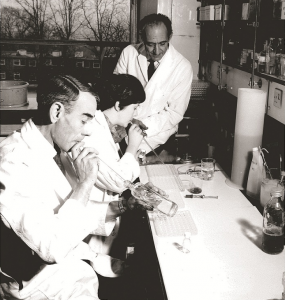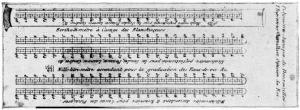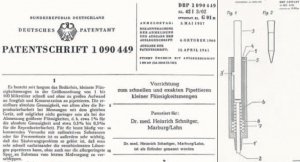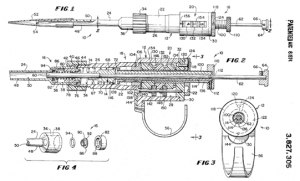Origins of the Pipette: Why Today’s Scientists Don’t Need to Use Their Mouths
by Meredith Wright My labmates and I recently found ourselves discussing mouth pipetting, an old technique where researchers used glorified straws as measuring tools. For reasons of accuracy, safety, and ‘ick’ factor, this practice has been largely eschewed in favor of hand-held micropipettes. A retired biochemist who consults for our lab told us that she, quite frankly, preferred mouth pipetting to more modern techniques. Her comments sent a shudder down my spine, as I imagined myself accidentally sipping LB media or hydrochloric acid. But, at the same time, I also started to think about how vital pipettes are to the basic functioning of a lab. Biology courses often teach us about great experiments of the past- think Hershey & Chase with their blender- but what about the humble tools that get tossed about on our lab benches? How did scientists transition from mouth pipetting to modern micropipettes?

The earliest pipettes date back to the 18th century, when French chemist, pharmacist, and inventor Francois Descroizilles developed the berthollimetre and alcalimetre, early precursors to the buret and pipette, respectively (Author’s note, I highly recommend reading this profile from 1951 of Francois Descroizilles; his career involved research on apple cider, lighthouses, and bleach, and the tone of the piece is very amusing). Joseph-Louis Gay Lussac later made slight modifications on Descroizilles’ work and coined the terms ‘buret’ and ‘pipette’ in 1824 (Lussac had an absurdly diverse career too it seems, studying the atmosphere via hot air balloon, discovering boron, and creating a scale for measuring alcohol content which is still used today). These early works appear similar to the graduated cylinders or serological pipettes found in a lab today, consisting of a simple tube with measurement markings.

It would appear the design of pipettes did not change drastically for quite some time, although somewhere along the line scientists started using their mouths to draw liquids up into these thin graduated tubes. But, even early on, the drawbacks of mouth pipetting were evident. A survey of 57 labs in 1915 found that 47 infections were associated with workplace practices, and more than 40% of those were attributed to the practice of mouth pipetting. Another study cited in this aptly-titled piece about mouth pipetting claims that, “the first recorded laboratory infection due to mouth pipetting occurred in 1893…[with] the case of a physician who accidentally sucked a culture of typhoid bacilli into his mouth.” Yikes. From what I can gather, we have Heinrich Schnitger, then a postdoc at the University of Marburg, Germany to thank for ending the days the mouth pipetting. Frustrated with trying to accurately pipette small volumes using the Carlsberg pipette (which involved creating a fine glass tube, calibrating the tube with mercury or a dye, and then pipetting by mouth), Schnitger developed his first prototype not long after starting his postdoc. His early pipettes featured the same basic elements that we find in today’s labs; a piston-driven pumping system, a spring against the piston for defining pipetting volume, and an air buffer to keep fluids from corroding the inner workings of the pipette. Further tinkering led to the addition of a second spring to allow the piston to be moved past the measured volume to eject residual fluid from the pipette tip. Schnitger filed for a patent in Germany in 1957, describing a ‘device for the fast and exact pipetting of small liquid volumes.’ The patent was granted in 1961.

While the Marburg pipette spread through Europe at the hands of Eppendorf, Gilson Inc. in the United States made their own model to market in the U.S. This model, patented in 1974 and developed primarily by Warren Gilson and Henry Lardy, is most notable for being adjustable, in contrast to Schnitger’s fixed volume pipettes. This Gilson model, bought by Rainin Instruments just before the patent was issued, is the most direct ancestor of the Pipetman that you might find on your own bench today. Different sources give credit for the first micropipette to Schnitger or Gilson, with many ignoring the other, and one accusing Gilson of ‘exploiting loopholes and weaknesses in patent law’ to copy Schnitger’s work. Regardless of who the first true inventor of the pipette was, there is no arguing that the pipette has become invaluable to modern molecular biology. The design has been tweaked over decades by scientists around the world, with additions made to make the device easier to handle while wearing gloves and the development of the multichannel pipette. Much like scientific knowledge itself, the pipette has evolved through the work of researchers building upon the genius of those before them.

Further Reading Duval, C. (1951). Francois Descroizilles, the inventor of volumetric analysis. Journal of Chemical Education, 28(10), 508–519. Klingenberg, M. (2005). When a common problem meets an ingenious mind The invention of the modern micropipette. EMBO Reports, 6(9), 7–10.

Cool! I didn’t realize mouth pipetting only went out as recently as the 70s! I do remember seeing a few old timers mouth pipetting in my early days. But today, don’t let Lab Safety catch you using this technique!
test smtp